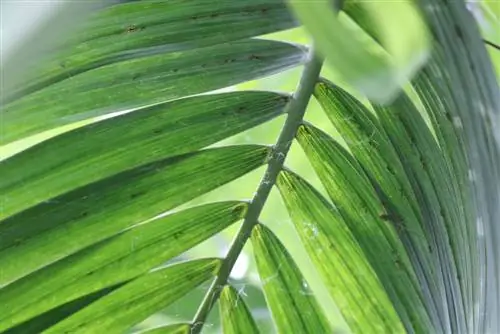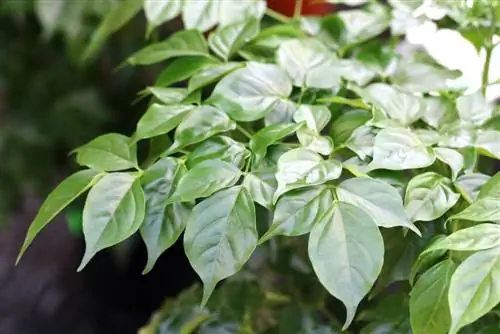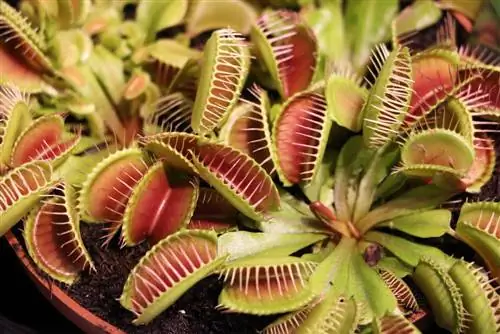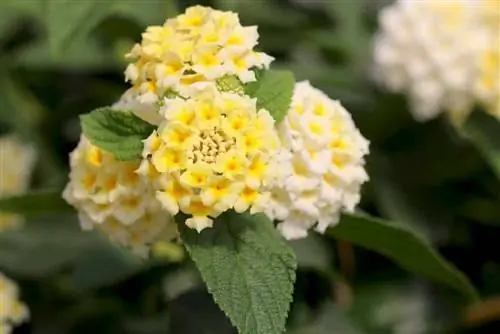- Author admin [email protected].
- Public 2023-12-17 03:39.
- Last modified 2025-01-24 12:45.
Wandry roses delight with colorful flower heads that modulate cheerfully from bright yellow to bright orange to rich red. The phenomenal flower display is closely linked to expert cultivation. Lantana camara come from tropical regions on the other side of the globe and are not prepared for a Central European winter. If the gardener is familiar with important aspects such as location, watering, fertilizing, cutting and overwintering, the flower festival repeats itself year after year. Read everything you need to know about the basics of caring for lantana here.
Location
Lantanas have a soft spot for full sun. The more sunshine the balcony flowers enjoy, the more opulent the flowers will be. Cool weather episodes in summer cause growth to stop. Only when the sun has driven away gloomy rain clouds and the thermometer rises does the floral spectacle continue. Lantana camara also appreciate a sheltered location so that gusts of wind do not ruffle the flowers. Please note that the outdoor season for lantana only begins when temperatures exceed 10 degrees at night.
Substrate
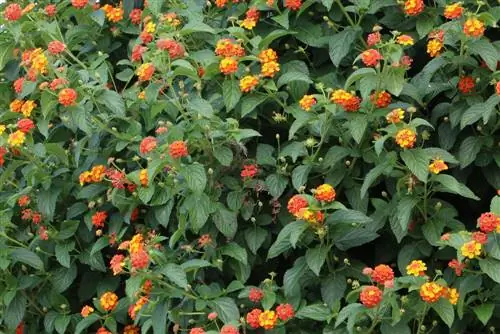
A nutrient-rich, well-drained substrate guarantees vital, flower-rich growth. Your lantana and Mother Nature will thank you if you ignore peat-rich potting soil from the discount store. A high peat content indicates inferior quality because a single drying phase is enough for the substrate to become massively compacted. In any case, peat substrates are frowned upon by environmentally conscious home gardeners because they no longer tolerate the overexploitation of irretrievable raised bogs. Lantanas like to spread their roots in high-quality container plant soil without peat. Here, additives such as lava granules or coconut fibers ensure optimal water storage with reliable permeability.
Stew
A young lantana from the garden center or grown by yourself has a vital start to the season if you pot it correctly. Please use a container that offers at least two finger-widths of space around the root ball. A floor opening acts as a drain for excess irrigation and rainwater. This is how you plant lantana correctly:
- Place the potted root ball in room temperature water
- Spread pottery shards or expanded clay balls over the floor opening as drainage
- Drainage should ideally be covered with an air and water permeable fleece
- Fill pot plant soil up to half to three-quarters height
- Unpot the water-soaked root ball and position it in the middle of the substrate
Fill pot plant soil in portions and press it down so that no cavities are created. A watering edge of one to two centimeters prevents water from spilling over. Please ensure that the previous planting depth is maintained. In the last step, water the lantana thoroughly.
From now on you should repot the magnificent verbena plant every two to three years in March according to this scheme. This means the pot can grow larger in proportion to growth. With its root ball squeezed into a depleted substrate, every lantana has a hard time repeating last year's blooms.
Tip:
Acclimatization effectively prevents leaf damage caused by sunburn. Before your lantana takes its place in the sun, it should stay in partial shade for a week. Even tropical sun worshipers benefit if the green leaves can gradually get used to direct sunlight.
Pouring
Naturally, lantanas can withstand short periods of drought without perishing. However, drought stress always comes at the expense of flower abundance. Therefore, ensure that the soil moisture is constant. Regularly check the condition of the substrate surface using a thumb test. If you don't feel any moisture up to a depth of 1 to 2 cm, watering is necessary. Please let the water, which is not too cold, run directly onto the root disk. Damp leaves unnecessarily attract fungal spores and pests. When the coaster fills up, your floral thirst is quenched. To protect against waterlogging, pour out the coaster after 10 minutes.
Fertilize
Adequate fertilization plays a key role in a successful care program. From the beginning of April to the end of August, supplementary nutrients keep growth and flowering going. Liquid flower fertilizer is easy to dose and poses little risk of over-fertilization. Add the fertilizer to the irrigation water weekly. Please water before and after with clear water so that nutrient s alts do not cause damage to dried roots and are better absorbed.
Wintering
Warmth-loving lantanas are not designed to overwinter outdoors. When the thermometer drops below 10 degrees Celsius in autumn, it is high time to move to winter quarters. You can overwinter the exotic flowering shrubs either in light or dark colors. How to do it right:
- Ideally set up brightly at 10 to 12 degrees Celsius
- Alternatively, hibernate in the dark at 5 to 8 degrees Celsius
- Avoid temperature fluctuations
- Stop giving fertilizer
- Water moderately so that the substrate does not dry out

If wintering is dark, cut the crown back by half before putting it away to reduce the stress of the lack of light. There is no cause for concern if your lantana sheds its leaves in winter quarters. The preparation phase for the new vegetation phase begins in mid to late February. Move the plant to a warmer, brighter location and water more again. Restore the nutrient supply by adding half the concentration of liquid fertilizer to the irrigation water every two weeks.
Cutting
Wandry roses bloom most beautifully on this year's branches. The best time for shape and maintenance pruning is in spring, shortly before fresh shoots begin. This applies equally to bushy shrubs and standard trees. This is how you prune lantana in an exemplary manner:
- Cut off dead and damaged shoots at the base
- Thin out branches that are directed towards the interior of the plant or are growing crosswise
- Short remaining shoots to 10 to 15 cm
- Ideally cut at a short distance above an outward facing blade or eye
Please use sharp secateurs with a bypass mechanism. Such models work with two sharp cutting edges that run past each other and leave smooth cuts. Anvil pruners, on the other hand, first press a shoot against a blunt side and cut the shoot with the sharp blade. Frayed and bruised cuts cannot be ruled out.
Basically, pruning care is limited to the annual topiary. The flower yield increases significantly if you take out the scissors every now and then in summer. Cut off any withered flower heads, clearing the way for more waiting buds. If a bunch of shoots are sticking out of shape on the standard trunk, don't hesitate to make a regular cut. Lantanas are naturally easy to cut and grow vigorously.
Tip:
Don't snack on the pretty berries. Lantana bears poisonous fruits that, even in small quantities, cause unpleasant symptoms. In the family garden, you should clean out wilted flower heads as soon as possible and avoid fruit decorations for safety reasons.
Propagation
A single mother plant is enough to transform the balcony and terrace into a summer sea of flowers with a whole flock of lantana. The vigorous verbena plants can be easily propagated using cuttings. For this purpose, cut off a shoot tip about ten centimeters long in spring. The lower half of the cutting is defoliated. Fill a pot with lean potting soil and insert the shoot two thirds into it. Only the remaining leaves should be above the surface of the earth.
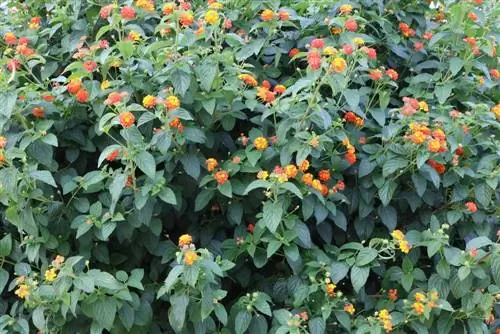
Water a cutting lightly and place the pot in a warm, bright window seat. A warm, humid microclimate optimizes rooting. Simply put a transparent cover in the form of a plastic bag over each offshoot. Contact between foil and plant parts could cause rot. Use long matches or similar wooden sticks as spacers. If the first new shoots sprout, the cover has done its job. Repot your young lantana in normal substrate.
Diseases and pests
Far from their tropical home regions, lantanas are susceptible to various diseases and pests. We have compiled common problems and tips for combating them for you below:
Grey mold (Botrytis)
The combination of high summer water requirements and dense foliage causes gray mold to appear. The fungal spores spread on shoots and leaves, visible as a dirty gray mold coating. The earlier you take countermeasures, the more promising the treatment. How to do it professionally:
- Isolate affected lantana from other plants
- Cut off affected shoots and dispose of them in household waste
- Carefully disinfect scissors before and after
Choose a quarantine location with plenty of sunshine and low humidity. Such conditions deprive fungal spores of their livelihood and support floral recovery. Under severe infestation pressure, you will be faced with the decision of removing the lantana or treating it with a fungicide, such as Duaxo Pilzfrei from Compo.
Aphids
The toxic ingredients in lantana do not prevent aphids from infesting them. Plants that are weakened primarily due to care errors are targeted by pests. Check the exotic potted plants regularly for louse infestation. This home remedy has proven to be excellent in the early stages:
- First, spray the lantana with as strong a jet of water as possible
- Dissolve 2 tablespoons of soft soap in 1 liter of boiled water
- On adult plants, add 1 to 2 dashes of alcohol
- Fill into a spray bottle or pressure sprayer
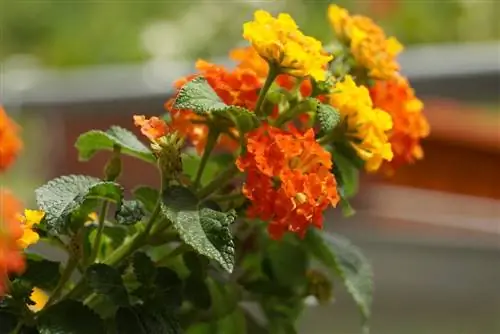
Spray infected shoots and the tops and bottoms of the leaves with soap solution. As with all home remedies, initial success in combating the disease can be seen after repeated use. The convincing effectiveness of soapy water against aphids has prompted numerous manufacturers of crop protection products to offer ready-made mixtures at reasonable prices.
Spider mites
In the winter quarters, spider mites lurk on lantana to suck on the juicy leaves. The tiny pests are almost invisible to the human eye. Telltale webs in the leaf axils and suction damage to the leaves leave little doubt as to who has settled here. The following control strategies have proven successful in practice:
- Put the lantana in a separate room
- Cover the root ball and rinse the plant thoroughly repeatedly
- Pack infected lantana in an airtight bag for a week
If mechanical control methods fail, you should seek help in the form of predatory mites. The tiny beneficial insects like to eat spider mites. Particularly in closed rooms at temperatures of 22 to 25 degrees Celsius, predatory mites not only destroy adult spider mites, but also destroy their eggs and larvae. The native gall midge species Feltiella acarisuga also targets spider mites. Both types of beneficial insects are bred in special farms and delivered to your home ready for use. The insects are completely harmless to humans. When spider mites are no longer to be found, predatory mites and gall midges migrate in search of new food sources.



